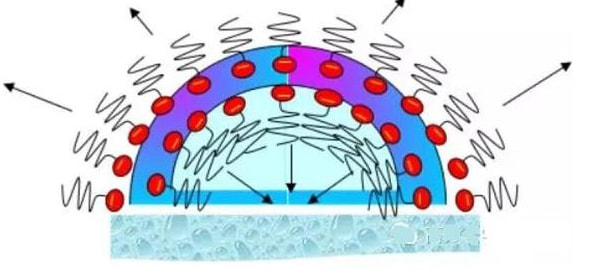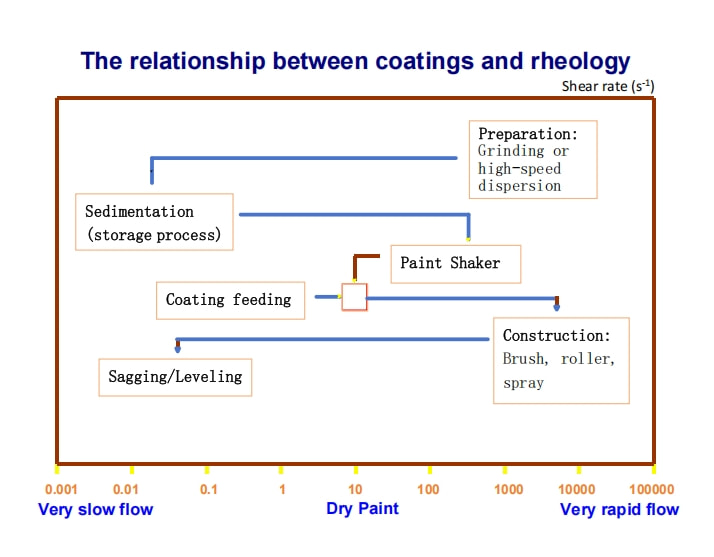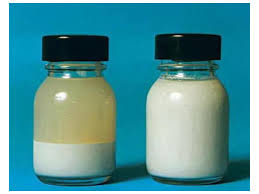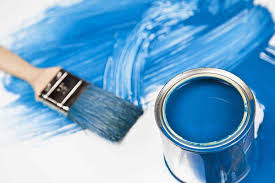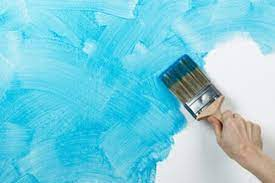
Antifoam y modificador de reología: pinturas y recubrimientos
Feb 07, 2025
La pintura es un material indispensable en la industria moderna y la vida diaria, y su rendimiento afecta directamente la calidad de los productos en los campos de construcción, automóviles, muebles, etc. Sin embargo, durante la producción y aplicación de pintura, una gran cantidad de La espuma se genera fácilmente debido a los tensioactivos en las materias primas y operaciones como agitar y bombear.
<33
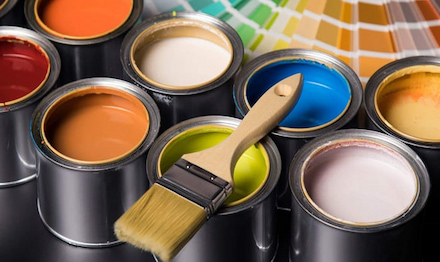
Además de ser hermosa, la pintura también puede formar una película sólida fuerte, que es un revestimiento protector, pero a menudo encuentra un problema, es decir, espuma. Las pinturas a base de agua y las pinturas a base de solvente utilizan diversos aditivos en sus formulaciones, como los dispersantes humectantes que hacen que los pigmentos y los rellenos sean fáciles de mojar, dispersar y estabilizar, aditivos que mejoran la estabilidad de almacenamiento de las pinturas terminadas, aditivos que ajustan la apariencia del Pinte película y algunos aditivos que logran funciones especiales. La mayoría de estos aditivos son tensioactivos, que pueden cambiar la tensión superficial de la pintura, que es un factor interno que hace que la pintura sea propensa a la espuma. Además, la extracción y la dispersión de alta velocidad durante la fabricación de pintura, y el corte durante la pulverización, el rodamiento y el cepillado durante la construcción de la aplicación, también aumentará la energía libre del sistema de pintura en diversos grados y generar espuma, que es un factor externo que es un factor externo que es que es un factor externo que es que es un factor externo que es genera espuma. <32 <33 <34 <35 <36 <37 <38Si la gran cantidad de espuma producida por la pintura no se elimina en el tiempo, causará varios defectos, como agujeros, agujeros de contracción, ojos de pescado, cáscara de naranja, etc. en la superficie cuando se pinta en el objeto, afectando el acabado y propiedades protectoras. <39 <40 <41 <42 <43 <44 <45 Peligros de espuma <46 <47 <48 <49 1. La espuma puede causar fácilmente la expansión del volumen, lo que resulta en una reducción de la utilización del equipo. <50 <51 <52 <53 2. La espuma limita la velocidad de agitación y prolonga el tiempo de mezcla de la pintura. <54 <55 <56 <57 3. La espuma afecta la humectación de pigmentos y rellenos. <58 <59 <60 <61 4. Una gran cantidad de espuma afecta el empaque de la línea de producción e interfiere con las operaciones de empaque. <62 <63 <64 <65 Importancia de los defoamers <66 <67 <68 <69 Los defoamers son uno de los aditivos indispensables en la industria de los recubrimientos, ya que rompen y suprimen rápidamente la espuma, aseguran procesos de producción y construcción de recubrimiento suave y mejoran la calidad y eficiencia del recubrimiento. <70 <71 <72 <73 <74 <75 <76 <77 <78 <79 <80 Â ¡Aplicación de desacuerdo de revestimiento <81 <82<83 <84 Enlace de producción <85 <86 <87 <88 Durante el proceso de mezcla y molienda de la pintura, la espuma puede causar problemas como la agitación desigual y la viscosidad anormal. El uso de agentes de enfermedad de alta eficiencia puede mejorar la eficiencia de producción y reducir las pérdidas de procesos. <89. <90 <91 <92 Enlace de almacenamiento <93 <94 <95 <96 Durante el almacenamiento, la pintura puede producir espuma debido a la temperatura ambiente y la vibración, lo que lleva a la sedimentación y la estratificación. Agregar agentes de desfoaming puede extender la estabilidad de almacenamiento de la pintura y garantizar la calidad del producto. <97 <98 <99 <100 Enlace de construcción <101 <102 <103 <104 Durante la construcción de la pintura, pulverización, cepillado, revestimiento de rodillos y otros métodos son propensos a afectar la suavidad y la plenitud de la película de recubrimiento debido a las burbujas. Los agentes de desfoaming pueden resolver rápidamente el problema de la espuma de construcción y mejorar el efecto de construcción. <105 <106 <107 <108 <109 <110 <111 <112 <113 <114 â ¢ · Mecanismo de defoaming de coacción Desfoamer <115 <116 <117 <118 <119 <120 <121 <122 Reduzca la tensión superficial <123: Desfoamers reducen la tensión en la superficie de la espuma, haciendo que la película de espuma sea más delgada y rompiendo más rápido. <124 <125 <126 <127 Efecto antifoaming <128: al formar una barrera en el punto de generación de espuma, evita un mayor crecimiento y agregación de burbujas. <129
<132 Difusión y humectabilidad <333: los desacopladores pueden difundirse rápidamente a la superficie de la espuma y humedecer la película de espuma, acelerando la disipación de la espuma. <134
<138
<140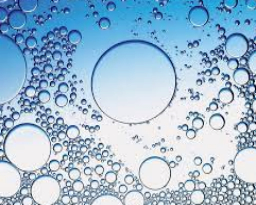 La eliminación de la espuma requiere tres procesos, a saber, la redistribución de burbujas, el adelgazamiento del grosor de la película y la ruptura de la película. Lleva mucho tiempo lograr la desfoaming natural después de estos tres procesos. Para resolver el pro <142 Blem de burbujas de pintura, es la clave agregar un defoamer para pintura. Paint Desfoamer es un aditivo químico agregado a la producción y el uso del dolor
La eliminación de la espuma requiere tres procesos, a saber, la redistribución de burbujas, el adelgazamiento del grosor de la película y la ruptura de la película. Lleva mucho tiempo lograr la desfoaming natural después de estos tres procesos. Para resolver el pro <142 Blem de burbujas de pintura, es la clave agregar un defoamer para pintura. Paint Desfoamer es un aditivo químico agregado a la producción y el uso del dolor
<145
<147<149 <150 <151 <152 <153 <154 <155 Modelo <156 <157 <158 <159 <160 <161 Apariencia <162 <163 <164 <165 <166 <167 Viscosidad (25 ° C) <168 <169
ph
100%
<280 <281 <282 <283 Silicona <284 <285 <286 <287 <288 <289 tinta aceitosa para tableros de circuito impreso <290 <291 <292 <293 Pintura de piso epoxi <294 <295 <296 <297 Adhesivo <298 <299 <300 <301 <302 <303 <304 <305 RK-73T <306 <307 <308 <309 <310 <111 <112 Líquido lechoso blanco o ligeramente amarillo <113 <114 <115 <116 <117 <118 1000 <119 ~ <320 5000 <321 MPAâ · S <322 <323 <324 <325 <326/<327 <328 <329 <330 <331 25 <332 ± <333 2 <334%<335 <336 <337 <338 <339 <340 Compuestos de silicona <341 <342 <343 <344 <345 <346 Varios sistemas de látex <347 <348 <349 <350 Pintura y barniz en sistemas a base de agua <351 <352 <353 <354 Sistemas de poliuretano, acrílico y epoxi a base de agua <355 <356 <357 <358 <359 <360 <361 <362 RK-918 <363 <364 <365<366 <367 <368 <369 Líquido translúcido gris claro <370 <371 <372 <373 <374 <375 150 <376 ~ <377 60 <378 0MPA · S <379 <380 <381 <382 <383/<384 <385 <386 <387 ï¼ 99%<388 <389 <390 <391 <392 Silicona <393 <394 <395 <396 <397 <398 Tinta a base de aceite para tableros de circuito impreso <399 <400 <401 <402 Pintura de piso epoxi <403 <404 <405 <406 Sistema adhesivo <407 <408 <409 <410 <411 <412 <413 <414 <415 RK-980P <416 <417 <418 <419 <420 <421 <422 LÍQUIDO DE ALCA OFFITA O LÍMIO LIGHT <423 <424 <425 <426 <427 <428 1 <429 00 ~ <430 15 <431 00MPA · S <432 <433 <434 <435 <436/<437 <438 <439 <440 <441 100%<442 <443 <444 <445 <446 <447 Aceite mineral <448 <449 <450 <451 <452 <453 Adhesivos de emulsión, todo tipo de pinturas de látex, adhesivos sensibles a la presión <454 <455 <456<457 Pinturas y tintas transmitidas por agua <458 <459 <460 <461 ácido acrílico, acetato de vinilo, ácido acrílico, ácido estireno-acrílico, copolímero y otros recubrimientos emulsionados <462 <463 <464 <465 látex <466 <467 <468 <469 <470 <471 <472 <473 RK-1100 <474 <475 <476 <477 <478 <479 <480 Líquido translúcido gris claro <481 <482 <483 <484 <485 <486 200 <487 0 ~ <488 50 <489 00MPA · S <490 <491 <492 <493 <494/<495 <496 <497 <498 <499 100 <500%<501 <502 <503 <504 <505 <506 Compuestos de silicona <507 <508 <509 <510 <511 <512 Proceso de producción de varios tipos de películas <513 <514 <515 <516 Adiciones internas de varios sistemas de películas <517 <518 <519 <520 Sistema adhesivo a base de aceite <521 <522 <523 <524 <525 <526 <527 <528 <529 <530 RK-2200 <531 <532 <533 <534 <535 <536 <537 Líquido transparente sin color a amarillo claro <538<539 <540 <541 <542/<543 <544 <545 <546/<547 <548 <549 <550 <551 100 <552%<553 <554 <555 <556 <557 <558 no silicio especial <559 <560 <561 <562 <563 <564 Sistema de poliuretano, epoxi, poliéster y adhesivo a base de aceite <565 <566 <567 <568 Tinta a base de aceite, tinta a base de agua, revestimiento y sistema de resina <569 <570 <571 <572 Sistema de curado UV sin solventes <573 <574 <575 <576 <577 <578 <579 <580 RK-8680 <581 <582 <583 <584 <585 <586 <587 Líquido translúcido gris claro <588 <589 <590 <591 <592 <593 10 <594 ~ <595 5 <596 00MPA · S <597 <598 <599 <600 <601/<602 <603 <604 <605 <606 100 <607%<608 <609 <610 <611 <612 Compuestos de silicona <613 <614 <615 <616 <617 Tinta a base de aceite para tableros de circuito impreso <618 <619 <620 <621 Pintura de piso epoxi <622 <623 <624 <625Solvente o adhesivo sin solvente <626 <627 <628 <629 <630 <631 <632 <633 RK-8777 <634 <635 <636 <637 <638 <639 <640 Líquido lechoso blanco o ligeramente amarillo <641 <642 <643 <644 <645 <646 500 ~ 5000MPAâ · S <647 <648 <649 <650 <651 <652 6.0-9.0 <653 <654 <655 <656 <657 <658 25 ± 1%<659 <660 <661 <662 <663 <664 Silicona <665 <666 <667 <668 <669 <670 Varios sistemas de látex <671 <672 <673 <674 Pinturas y barnices en sistemas a base de agua <675 <676 <677 <678 <679 <680 <681 <682 <683 RK-8865 <684 <685 <686 <687 <688 <689 <690 ligeramente tur <691 BID Liquid <692 <693 <694 <695 <696 <697 100 <698 ~ <699 100 <700 0MPA · S <701 <702 <703 <704 <705/<706 <707 <708 <709 <710 ï¼ <711 90%<712 <713 <714 <715 <716 <717 Silicona <718 <719 <720 <721<722 <723 Pintura de contenedor <724 <725 <726 <727 Pintura de muebles <728 <729 <730 <731 recubrimientos arquitectónicos e industriales <732 <733 <734 <735 Todo tipo de sistemas de pintura de látex <736 <737 <738 <739 barniz <740 <741 <742 <743 <744 <745 <746 <747 RK-8875 <748 <749 <750 <751 <752 <753 <754 Líquido ligeramente turbio <755 <756 <757 <758 <759 <760 3 <761 00 ~ <762 10 <763 00MPA · S <764 <765 <766 <767 <768/<769 <770 <771 <772 <773 ï¼ <774 95%<775 <776 <777 <778 <779 <780 Silicona <781 Compuestos <782 <783 <784 <785 <786 <787 Sistemas epoxi a base de agua <788 <789 <790 <791 Tintas flexográficas a base de agua <792 <793 <794 <795 acrílicos a base de agua y acrílicos mixtos <796 <797 <798 <799 Pinturas de látex acrílico de estireno para recubrimientos de pared arquitectónicos <800 <801 <802 <803Proceso de molienda de pasta de color a base de agua <804 <805 <806 <807 Pinturas de látex acrílico de estireno para recubrimientos de pared arquitectónicos <808 <809 0 1 2 3 4 5 R 6 K-887 7 6 8 9 <820 <821 <822 <823 Líquido ligeramente turbio <824 <825 <826 <827 <828 3 <829 00 ~ <830 10 <831 00MPA · S <832 <833 <834 <835/<836 <837 <838 <839 <840 ï¼ <841 95 <842%<843 <844 <845 <846 <847 <848 Silicona <849 Compuestos <850 <851 <852 <853 <854 <855 Sistema epoxi a base de agua <856 <857 <858 <859 Pintura de contenedor <860 <861 <862 <863 Pintura de látex de poliuretano acrílico para madera <864 <865 <866 <867 PINTURA DE LATEX ACRYLIC DE STIRENO PARA ENCENDIDO DE CUMBIENTES DE LA MUBALES <868 <869 <870 <871 Tinta de impresión flexecia transmitida por el agua, removedor de superposición acrílica a base de agua <872 <873 <874 <875 Proceso de molienda de pasta de color a base de agua <876 <877 <878 <879Ácido acrílico a base de agua y ácido acrílico mixto <880 <881 <882 <883 <884 <885 <886 <887 RK-9110S <888 <889 <890 <891 <892 <893 leche <894 y <895 -W <896 Hite Liquid <897 <898 <899 <900 <901 <902 200 <903 0 ~ <904 50 <905 00MPA · S <906 <907 <908 <909 <910 <911 6. <912 5 <913 ~ <914 8.5 <915 <916 <917 <918 <919 <920 5 <921 0â ± 1%<922 <923 <924 <925 <926 <927 Silicona <928 <929 <930 <931 <932 <933 tinta a base de agua <934 <935 <936 <937 Producción y fabricación de adhesivos <938 <939 <940 <941 Producción y fabricación de varios de pintura de látex <942 <943 <944 <945 Varios de la pintura a base de agua, que prestan más atención al proceso de molienda <946 <947 <948 <949 <950 <951 <952 <953 R <954 K-9855 <955 <956 <957 <958 <959 <960 Líquido lechoso blanco o ligeramente amarillo <961 <962 <963 <964 <965 <966500 <967 ~ <968 50 <969 00MPAâ · S <970 <971 <972 <973 <974 <975 6.0-9.0 <976 <977 <978 <979 <980/<981 <982 <983 <984 <985 Silicona <986 <987 <988 <989 <990 <991 Varios sistemas de látex <992 <993 <994 <995 recubrimiento a base de agua <996 <997 <998 <999 Impresión de tinta <1000 <1001 <1002 <1003 Adhesivo <1004 <1005 <1006 <1007 <1008 <1009 <1010 <1011 RK-9860 <1012 <1013 <1014 <1015 <1016 <1017 Líquido nublado <1018 <1019 <1020 <1021 <1022 <1023 5 <1024 00 ~ <1025 20 <1026 00MPA · S <1027 <1028 <1029 <1030 <1031/<1032 <1033 <1034 <1035 <1036 ï¼ <1037 95%<1038 <1039 <1040 <1041 <1042 <1043 Silicona <1044 Compuestos <1045 <1046 <1047 <1048 <1049 <1050 recubrimiento industrial <1051 <1052 <1053 <1054 Concentrado de pigmento <1055 <1056 <1057 <1058 Tinta de impresión, aceite de brillo <1059<1060 <1061 <1062 Pintura de madera y pintura de muebles <1063 <1064 <1065 <1066 Pintura arquitectónica <1067 <1068 <1069 <1070 <1071 <1072 <1073 <1074 RK-9864 <1075 <1076 <1077 <1078 <1079 <1080 ligeramente <1081 líquido turbio <1082 <1083 <1084 <1085 <1086 <1087 1 <1088 00 ~ <1089 10 <1090 00MPA · S <1091 <1092 <1093 <1094 <1095/<1096 <1097 <1098 <1099 100%<1100 <1101 <1102 <1103 <1104 Silicona <1105 Compuestos <1106 <1107 <1108 <1109 <1110 <1111 Proceso de molienda de colorantes a base de agua <1112 <1113 <1114 <1115 Sistema epoxi basado en agua <1116 <1117 <1118 <1119 Sistema de emulsión acrílica pura <1120 <1121 <1122 <1123 <1124 <1125 <1126 Sistema de ácido de estireno/acrílico <1127 <1128 <1129 <1130 Alcohol polivinílico (PVA) <1131 <1132 <1133 <1134 <1135 <1136 <1137 <1138 <1139 <1140 <1141 RK-170A <1142<1143 <1144 <1145 <1146 Líquido opaco claro a color amarillo claro <1147 <1148 <1149 <1150 <1151 <1152 300 ~ 1000MPAâ · S <1153 <1154 <1155 <1156 <1157 5.0-7.0 <1158 <1159 <1160 <1161 100%<1162 <1163 <1164 <1165 <1166 Aceite mineral <1167 <1168 <1169 <1170 <1171 <1172 Producción de adhesivos y varios tipos de pinturas de látex <1173 <1174 <1175 <1176 Sistemas de recubrimiento transmitidos por el agua basados en la emulsión de fenilpropileno, el propileno de silicona <1177 <1178 <1179 <1180 emulsión, emulsión de propileno puro, etc. <1181 <1182 <1183 <1184 Todos los tipos de látex a base de agua (estireno/butadieno, acrílico, PVC y sus copolímeros, EVA, <1185 <1186 <1187 <11. <1190 <1191 <1192 recubrimiento de papel <1193 <1194 <1195 <1196 <1197 <1198 <1199 <1200 <1201 <1202 <1203 <1204 <1205 <1206 <1207 <1208 <1209 Relación entre el modificador de reología y <1210Reubique Rheology <1111 <1212 <1213 <1214 <1215 <1216 <1217 <1218 Como un producto industrial común, el rendimiento y la calidad de los recubrimientos se ven muy afectados por la reología (es decir, las características de flujo y deformación de una sustancia bajo fuerzas externas). La aplicación de la reología en los recubrimientos se refleja especialmente en el almacenamiento, la construcción y el efecto final de los recubrimientos. Rheology puede ayudarnos a comprender y controlar mejor las diversas propiedades de los recubrimientos, mejorando así la estabilidad y el efecto de construcción de los recubrimientos. <1219 <1220 <1221 <222 <1223 <1224 <1225 <226 <1227 <1228 <1229 <1230 <1231 <1232 <1233 Cuatro aplicaciones principales de recubrimientos y reología <1234 <1235 <1236 <1237 <1238 Almacenamiento de pintura: sedimentación <1239 <1240 <1241 <1242 <1243 <1244 <1245 S <1246 Edimentation es el proceso por el cual los pigmentos, los rellenos y otros materiales sólidos se hunden en el fondo de un contenedor bajo la influencia de la gravedad. La sedimentación pigmentaria es un fenómeno de baja tasa de corte: las tasas de corte involucradas son inferiores a 10 <1247 -2 <1248 <1249 S <1250 -1 <1251, por lo que la viscosidad de la pintura a esta velocidad de corte es crítica para evitar que el pigmento se asiente. <1252 <1253 <1254 <1255 <1256 <1257 <1258 Durante el almacenamiento de pintura, la reología juega un papel vital. Una pintura ideal debe tener buenas propiedades de suspensión para evitar la precipitación de sustancias sólidas como pigmentos y rellenos. Rheology <1259 M <1260 Los odificadores pueden reducir estos fenómenos de sedimentación ajustando la viscosidad de la pintura y mantener la estabilidad de la pintura. <1261 <1262 <1263 <1264 <1265 <1266 <1267 <1268 Métodos comunes para superar la sedimentación: <1269 <1270 <1271 <1272 <1273 <1274 <1275 <1276 Balancee el diseño de filtros/circuitos (use un diseño de circuito pequeño en lugar de un diseño de circuito parcialmente ampliado) <1277 <1278 <1279 <1280 Minimice la cantidad de solventes y tensioactivos, lo que reducirá el bajo esfuerzo cortante bajo viscosidad <1281 <1282 <1283 <1284 Aumente la viscosidad bajo cizallamiento bajo seleccionando <1285 R <1286 Modifie de heología <1287 RS <1288 <1289 <1290 <1291Agregue una pequeña cantidad (0.5-2 g/L) de HEC para aumentar la baja viscosidad de corte. Sin embargo, afectará la fluidez y la nivelación y el rendimiento anti-Splash. <1292 <1293 <1294 <1295 <1296 <1297 <1298 <1299 <300 <301 <302 <303 <1304 Aplicación de recubrimiento: sumergir <305 <306 <307 <308 <309 <1310 <1311 <1312 El recubrimiento de inmersión es una operación en condiciones de velocidad de corte media <1313 (10-100 segundos <1314 -1 <1315) <1316. <1317. <1318 <1319 <1320 <321 El recubrimiento <322 es muy viscoso y estructuras cuando todavía está en la lata. Por lo general, se siente que este recubrimiento es difícil de aplicar. <1324 <325 <326 <1327 El recubrimiento <328 es muy delgado en la lata, lo que causará goteo durante la transferencia de cepillos, flacidez severa en las superficies verticales <1329 du <1330 Aplicación de anillo y salpicaduras durante la aplicación de rodillos. <1331 <332 <333 <334 <335 <336 <337 <338 <1339 Control la viscosidad del recubrimiento en este rango de velocidad de corte afectará el rendimiento bajo estos cizallas medianas <1340 C <1341 onditions (apariencia de lata, inmersión, agitación). <1342<343 <344 <345 Durante el proceso de solicitud de recubrimiento, la inmersión (cepillado o inmersión) requiere que el recubrimiento tenga la viscosidad apropiada en <1346 para controlar la fluidez del recubrimiento y evitar gotear. Al ajustar la viscosidad del recubrimiento, el <3447 R <1348 heology <349 m <350 Odificador puede garantizar que el recubrimiento fluya uniformemente durante la aplicación, evitando un flujo demasiado rápido o la formación de recubrimiento desigual. <1351 <352 <353 <354 <355 <356 <357 <1358 <1359 <360 <361 <362 <363 <364 <365 <366 <367 <368 <369 <1370 <371 <372 <1373 <374 <375 <376 <377 <1378 Aplicación de pintura: plenitud de película de pintura <1379 <1380 <381 <382 <383 Las operaciones de cepillado, rodamiento y pulverización dependen de la viscosidad a altas velocidades de corte <1384 ( 10 <1385 3 <1386 Sec <1387 -1 <1388): <1389 <390 <391 <392Cuanto mayor sea la viscosidad a altas velocidades de corte, mayor es la resistencia a la distribución de la pintura durante la aplicación, por lo que se puede obtener una película de pintura más gruesa en una sola aplicación. Por el contrario, la baja viscosidad a altas tasas de corte significa que la pintura es menos resistida cuando se distribuye, y la pintura es más fácil de extender en la superficie del sustrato. La película de pintura correspondiente es más delgada, lo que resulta en una potencia oculta reducida. <1393 <394 <395 <396 La plenitud de la película de pintura es un factor clave que afecta la apariencia y la durabilidad del recubrimiento. Durante el proceso de construcción, la pintura debe tener una viscosidad suficiente para formar una película de pintura gruesa y uniforme en la superficie, evitando un recubrimiento débil o desigual causado por una viscosidad demasiado baja. <1397 <398 <399 <400 <1401 <402 <1403 Construcción de pintura: flujo y caída <1404 <1405 <406 <407 La nivelación y la flacidez se refieren a la fluidez de la pintura después del recubrimiento. La fluidez demasiado alta hará que la pintura no pueda recubrir uniformemente y se hunde, mientras que la fluidez demasiado baja hará que la superficie de recubrimiento sea rugosa. La adición de <408 R <409 heology <410 m <411El odificador puede ajustar efectivamente la nivelación de la pintura, haciendo que la superficie de recubrimiento sea suave y uniforme. <1412 <1413 <414 <415 <416 <1417 <1418 <419 Factores que afectan la nivelación y la flacidez: <420 <1421 <422 <423 <424 <1425 Pinte de espesor de la película, <426 <427 <1428 <1429 Velocidad de secado, <1430 <1431 <1432 <433 Viscosidad (en condiciones de baja cizallamiento) <434 <1435 <1436 <1437 <1438 <1439 <440 <441 <442 Los objetivos de nivelación máxima y sag mínimo son conflictivos. <443 <444 <445 <446 <447 <448 Viscosidad reducida a bajas tasas de corte ayuda a nivelar, pero aumenta el SAG. <449 <450 <1451 <452 El aumento del grosor de la película acelera la nivelación, pero también aumenta el SAG. <453 <454 <455 <456 <457 <1458 <459 <1460 <1461 <462 <463 <464 <465 <466 <467 <1468 <469 <1470 <1471 Modelo <472 <473 <474 <475 <476 <477 Apariencia <478 <479 <480 <1481 <482 <483 Tipo químico <484<485 <486 <1487 <488 Contenido <489 <490 <1491 <1492 Valor de pH <493 <1494 <495 <496 <1497 Como viscosidad suministrada, CP <498 <499 <1500 <1501 <1502 <1503 densidad, lb/galón <1504 <1505 <1506 <1507 <1508 <1509 Aplicación: <1510 <1511 <1512 <1513 <1514 <1515 <1516 T-10 <1517 <1518 <1519 <1520 <1521 Líquido brumoso <1522 <1523 <1524 <1525 <1526 <1527 Heur no iónico <1528 <1529 <1530 <1531 <1532 25%<1533 <1534 <1535 <1536/<1537 <1538 <1539 <1540 1800-4000 <1541 <1542 <1543 <1544 8.6-8.8 <1545 <1546 <1547 <1548 <1549 Adecuado para varias formulaciones de pintura de látex <1550 <1551 <1552 <1553 Totalmente compatible con otros modificadores de reología. <1554 <1555 <1556 <1557 <1558 <1559 <1560 T-20 <1561 <1562 <1563 <1564 20%<1565<1566 <1567 <1568/<1569 <1570 <1571 <1572 2500-4500 <1573 <1574 <1575 <1576 8.6-8.8 <1577 <1578 <1579 <1580 <1581 Adecuado para varias formulaciones de pintura de látex <1582 <1583 <1584 <1585 Totalmente compatible con otros modificadores de reología. <1586 <1587 <1588 <1589 <1590 <1591 <1592 T-30 <1593 <1594 <1595 <1596 20%<1597 <1598 <1599 <1600/<1601 <1602 <1603 <1604 2000-5000 <1605 <1606 <1607 <1608 8.6-8.8 <1609 <1610 <1611 <1612 <1613 <1614 T-40 <1615 <1616 <1617 <1618 17.5%<1619 <1620 <1621 <1622/<1623 <1624 <1625 <1626 2000-4000 <1627 <1628 <1629 <1630 8.4-8.8 <1631 <1632 <1633 <1634 <1635 <1636 T-50 <1637 <1638 <1639 <1640 30%<1641 <1642 <1643 <1644/<1645 <1646 <1647 <1648 3000-6000 <1649 <1650 <1651 <16528.6-8.8 <1653 <1654 <1655 <1656 <1657 <1658 T-60 <1659 <1660 <1661 <1662 40%<1663 <1664 <1665 <1666/<1667 <1668 <1669 <1670 7000-15000 <1671 <1672 <1673 <1674 8.6-8.8 <1675 <1676 <1677 <1678 <1679 <1680 T-7 <1681 0 <1682 <1683 <1684 <1685 50%<1686 <1687 <1688 <1689/<1690 <1691 <1692 <1693 12000-20000 <1694 <1695 <1696 <1697 8.6-8.8 <1698 <1699 <700 <1701 <1702 <703 T-80 <704 <1705 <1706 <707 25%<1708 <1709 <1710 <711/<1712 <1713 <1714 <715 3000-5000 <716 <1717 <1718 <1719 8.6-8.8 <720 <1721 <1722 <1723 <1724 <725 T-90 <726 <1727 <1728 <729 <730 Off-blancos y lácteos lácteos <731 <1732 <1733 <1734 <1735 <736 HASE aniónico <737 <1738 <1739 <1740 <741 30%<742 <1743 <1744 <7452.5-3.5 <746 <1747 <1748 <1749 <750 <50 <1751 <1752 <1753 <1754 <755 8.7-8.9 <756 <1757 <1758 <1759 <760 C <1761 ompatible con muchos otros modificadores de reología <762 <1763 <1764 <1765 <1766 <1767 <1768 T-100 <1769 <1770 <1771 <772 30%<773 <1774 <1775 <776 2.0-4.0 <777 <1778 <779 <1780 ï¼ 50 <781 <1782 <1783 <1784 8. <1785 7-8.9 <1786 <1787 <1788 <1789 <1790 C <1791 ompatible con muchos otros modificadores de reología <792 <1793 <1794 <1795 <1796 <1797 <798 T-101 <799 <1800 <1801 <802 30%<1803 <1804 <1805 <806 2.5-3.5 <807 <1808 <1809 0 ï¼ 50 <1811 <1812 <1813 <1814 8. <1815 7-8.9 <1816 <1817 <1818 <1819 Compatible con una variedad de formulaciones de pintura de látex <1820 <1821 <1822 P <1823 Articularmente bien adecuado para vinilo- <1824 <1825 <1826 <1827Formulaciones interiores acrílicas, planas y bajas de color bajo <1828 <1829 <1830 <1831 <1832 <1833 <1834 T-102 <1835 <1836 <1837 <1838 30%<1839 <1840 <1841 <1842 2.5-3.5 <843 <1844 <1845 <1846 ï¼ 50 <847 <1848 <1849 <1850 8. <1851 7-8.9 <852 <1853 <1854 <1855 <1856 <857 T-103 <1858 <1859 <1860 <1861 30%<862 <1863 <1864 <1865 2.0-4.0 <866 <1867 <1868 <1869 ï¼ 50 <870 <1871 <1872 <1873 8. <1874 7-8.9 <875 <1876 <1877 <1878 <1879 <880 T-104 <1881 <1882 <1883 <1884 30%<1885 <1886 <1887 <1888 2.5-3.5 <889 <1890 <1891 <1892 ï¼ 50 <893 <1894 <1895 <1896 8. <1897 7-8.9 <1898 <1899 <1900 <1901 <1902 <1903 D-105 <1904 <1905 <1906 <1907 <1908 C <1909 Lear Brown Liquid <1910 <1911 <1912 <1913 <1914 <1915 Copolímeros hidrofílicos <1916 <1917<1918 <1919 <1920 48%<1921 <1922 <1923 <1924 7.0-8.0 <1925 <1926 <1927 <1928/<1929 <1930 <1931 <1932 9.6-9.8 <1933 <1934 <1935 <1936 <1937 C <1938 ompatible con el hase aniónico y la reología asociativa de Heur no iónico <1939 <1940 <1941 <1942 Modificadores <1943 <1944 <1945 <1946 <1947 <1948 <1949 D-106 <1950 <1951 <1952 <1953 35%<1954 <1955 <1956 <1957 7.0-8.0 <1958 <1959 <1960 <1961/<1962 <1963 <1964 <1965 9.2-9.4 <1966 <1967 <1968 <1969 c ompatible con el hase aniónico y la reología asociativa de Heur no iónico Modificadores <177 <1978 <1979 <180
D-107 <833 <184 <185
<187 Brown Liquid
<189 <1990 <151 <152 <1993 Copolímeros hidrofílicos <1994 <1995 <1996 <1997<1998 30%<1999 <2000 <2001 <2002 9.0-11.0 <222 que <2004 <2005 <2006/<2007 <2008
